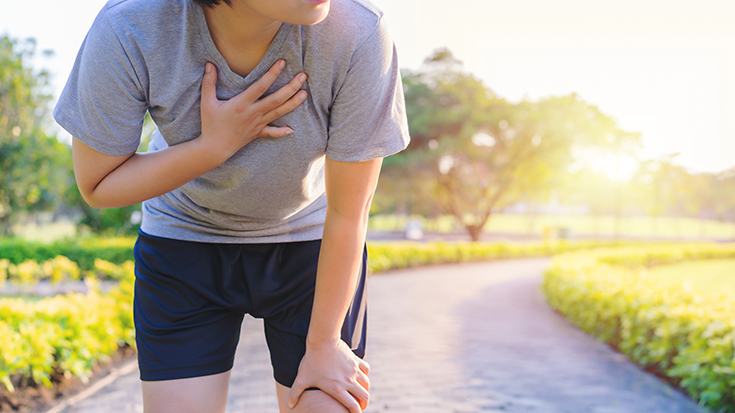
The sudden cardiac arrest suffered by Buffalo Bills safety Damar Hamlin during a regular season football game with the Cincinnati Bengals last January has raised concerns about the heart-related risks inherent in athletics. What do respiratory therapists need to know about these risks and how can they use that knowledge to help their young patients and their parents better mitigate it?
We asked two RTs associated with The Ohio State University’s advanced practice respiratory therapist program, faculty member Jessica Schweller, MS, APRN-CNP, RRT, RRT-SDS, CCSH, AE-C, and recent graduate Andrew Shonk, MRT, RRT, RRT-NPS, from Nationwide Children’s Hospital, to explain.
Fortunately, it’s rare
How common is it for an athlete, young or older, to develop sudden cardiac arrest during a practice or game? According to Shonk, the good news is, sudden cardiac arrest from exercise or a sports-related activity is rare.
“Conditions that increase the risk of cardiac arrest are blunt force chest impact, myocarditis after illness, congenital heart defects or conductive pathway issue from birth, and some rare heart rhythm disorders,” he said.
Even in those situations, mild to moderate exercise and sports activity is generally encouraged for good health.
Of course, many athletes have no idea they have a cardiac issue. “Some athletes may be born with a mild congenital condition that is either undiagnosed or benign, allowing them to continue sports,” said Schweller. “When strenuous physical activity occurs, it may push the limits on their cardiovascular system, therefore increasing the risk of cardiac arrest.”
She says dehydration can also cause electrolyte imbalances that can lead to arrhythmias, and cases of cardiomyopathy, or thickening of the heart muscle, have increased in young adults due to both COVID vaccinations and COVID-positive illness, raising the risk of cardiac arrest.
“Many of these athletes and families are unaware of any possible health risk until an event occurs,” she continued. “Symptoms may precipitate an event, but what we have witnessed thus far is that many of these athletes are asymptomatic or just feel they are working out harder.”
How to prevent it
What can athletes and their trainers do to mitigate the risk factors for cardiac arrest?
Schweller believes thoroughly screening all athletes for heart conditions is key, regardless of whether they have a prior history of heart disease or family history of heart disease. “There are national programs that collaborate with school systems to provide athletes and their families low-cost cardiac screenings that include both an electrocardiogram and echocardiogram to assess the heart,” she said. “It can be used to diagnose a cardiac condition in asymptomatic athletes.”
She said the athlete’s primary care provider, coach, and trainers should all be made aware of any previous COVID diagnosis as well, so the athlete can be monitored closely post-illness and sent for a thorough cardiac evaluation prior to returning to full capacity in the sport. This monitoring should be conducted above and beyond the regular annual sports physical.
“Educating athletes, caregivers, coaches, and trainers on the signs and symptoms of cardiovascular abnormalities can be important so that they can identify when to call for help and how to assist,” she emphasized. She also urges greater attention to maintaining adequate hydration, temperature regulation, rest, and avoidance of over exertion to help keep athletes safe.
Having an external defibrillator readily available and knowing how to use it is essential in saving an athlete’s life should a cardiac event occur.
Remain vigilant for signs and symptoms
What can respiratory therapists do to help their patients, and perhaps especially the parents of their young patients who are participating in sports, better understand the cardiac risks involved in athletics and what they can do to minimize those risks wherever possible?
Andrew Shonk says family history of cardiac disease or heart attack is the number one risk factor, but all athletes and their parents should be advised to remain vigilant for the signs and symptoms of possible trouble. “Athletes, and parents of athletes, should always consider that shortness of breath, dizziness or fainting, or chest pain after exercise or sports is a concern and should be investigated by a doctor,” he said.
He also urges therapists to advocate for correct fitting of protective padding for contact sports to prevent blunt chest injuries and encourage their young patients who play sports to listen to what their bodies are telling them.
“Athletes should know their limitations of intense exercise and pay close attention to their heart beat patterns and sensations,” he said.
Email newsroom@aarc.org with questions or comments, we’d love to hear from you.















